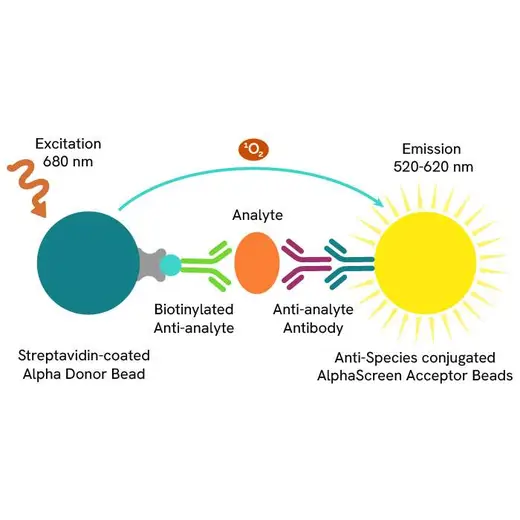

 下载产品说明书
下载产品说明书 下载SDS
下载SDS 用小程序,查商品更便捷
用小程序,查商品更便捷



 收藏
收藏
 对比
对比 咨询
咨询Overview
Features:
- No-wash steps, no separation steps
- ELISA alternative technology
- Sensitive detection
- Broad range of affinities
- High avidity
- Results in less than 3 hours
- Half the time of an ELISA assay
AlphaLISA technology allows the detection of molecules of interest in buffer, cell culture media, serum and plasma in a highly sensitive, quantitative, reproducible and user-friendly mode. In an AlphaLISA assay, a biotinylated CD86 binds to the Streptavidin-coated Alpha Donor beads, while His tagged CTLA-4 is captured by Anti-His AlphaLISA Acceptor beads. When CD86 binding to CTLA-4 happens, Donor beads and Acceptor beads come into close proximity. The excitation of the Donor beads provokes the release of singlet oxygen molecules that triggers a cascade of energy transfer in the Acceptor beads, resulting in a sharp peak of light emission at 615 nm.
Human Cytotoxic T-lymphocyte-associated protein 4 (CTLA-4), also known as CD152 (cluster of differentiation 152), is a cell membrane receptor and a member of immunoglobulin superfamily. CTLA-4 is expressed once a T cell becomes active and modulates T cell signals by blocking the CD80 (B7.1) and CD86 (B7.2) ligands from binding to CD28. CTLA-4, functioning as an immune checkpoint, downregulates T cell immune responses. Because of its profound inhibitory role blocking CTLA-4 and CD80 or CD86 binding has been considered as promising therapeutic target for human autoimmune disease and cancers.
Specifications
| Application | Protein-protein interactions |
|---|---|
| Assay Points | 5000 |
| Assay Target Class | Protein |
| Automation Compatible | Yes |
| Brand | AlphaLISA |
| Detection Method | Alpha |
| Shipping Conditions | Shipped in Blue Ice |
| Therapeutic Area | Immuno-oncology |
| Unit Size | 5,000 Assay Points |







 危险品化学品经营许可证(不带存储) 许可证编号:沪(杨)应急管危经许[2022]202944(QY)
危险品化学品经营许可证(不带存储) 许可证编号:沪(杨)应急管危经许[2022]202944(QY)  营业执照(三证合一)
营业执照(三证合一)